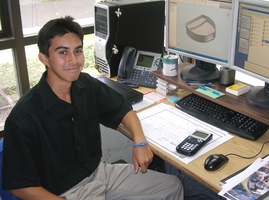Home Island: Hawaii Island
High School: Waiakea High School
Institution when accepted: University of Hawaii at Manoa
Anthony is now co-founder of a robotics start-up company in Hilo, Hawaii
Akamai Project: 3-D Modeling of the CFHT Declination Gearbox
Project Site: Canada-France-Hawaii Telescope
Mentor: Steven Bauman
Project Abstract:
The Canada-France-Hawaii Telescope (CFHT) has been in operation since 1979. Due to the telescope’s age, mechanical parts are beginning to show signs of wear and may soon fail. This can result in poor observing and ultimately telescope downtime. Recently, increased telescope pointing errors indicated that original gears in the telescope’s declination gearbox were showing symptoms of wear. The declination gearbox is responsible for the telescope’s motion about one of its two rotation axes. The primary purpose of this project is to generate a 3-D computer-aided design (CAD) model of the entire gearbox. The new 3-D CAD model will replace the telescope’s original hand-drawn 2-D mechanical plans, and the model will be verified via functional animation of the gearbox’s moving parts in the CAD program. Using the newly created CAD models, manufacturers can then be contacted and custom replacement parts will be ordered. The completed model can also be used to create a parts list for the gearbox, an animated assembly/disassembly tutorial, and a stress analysis test to determine areas of possible failure in the future. Creation of this CAD model of the declination gearbox will facilitate rapid mechanical repairs when needed, and help avert catastrophic telescope failure by allowing for preemptive replacement of worn or damaged parts.
